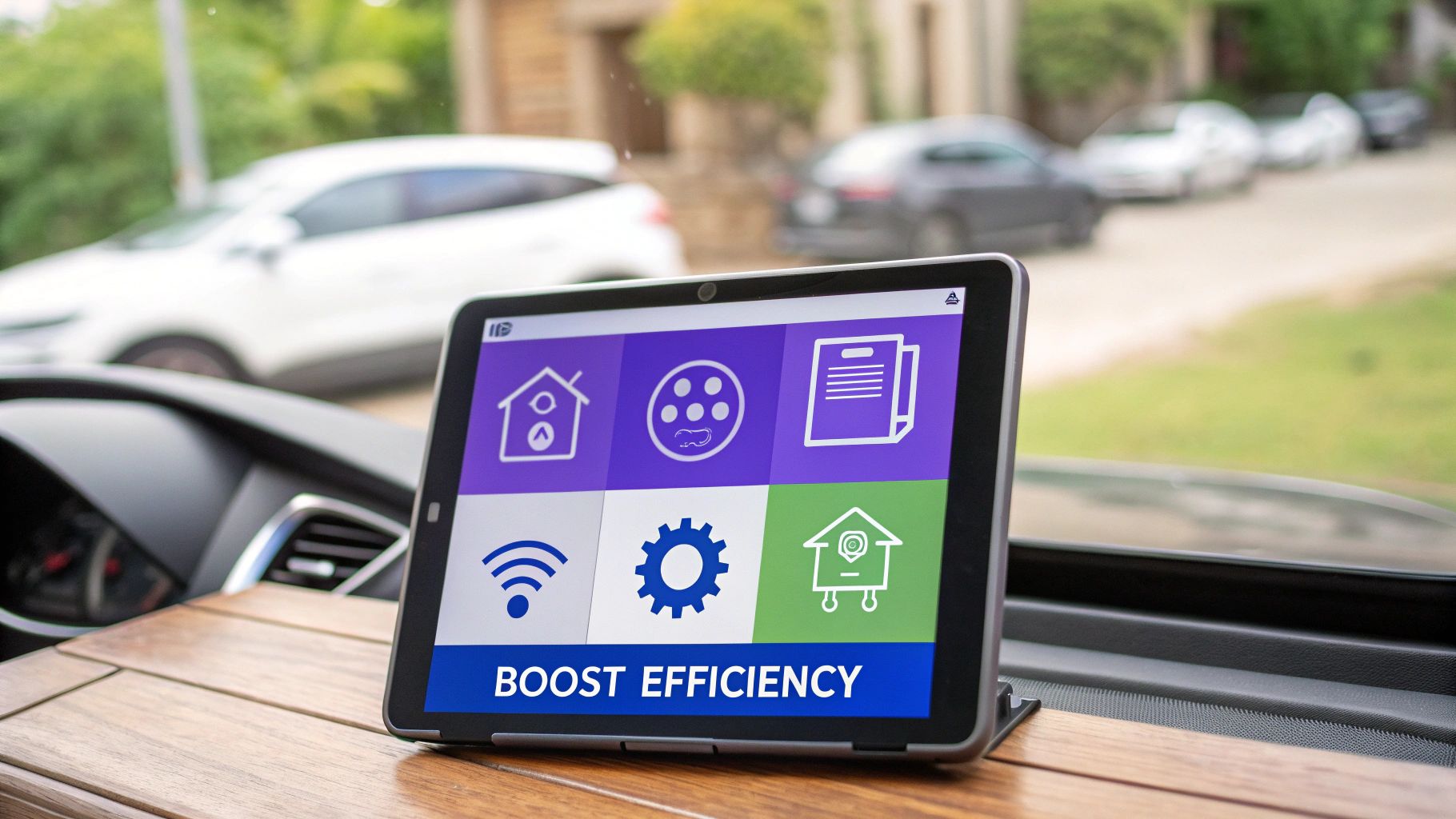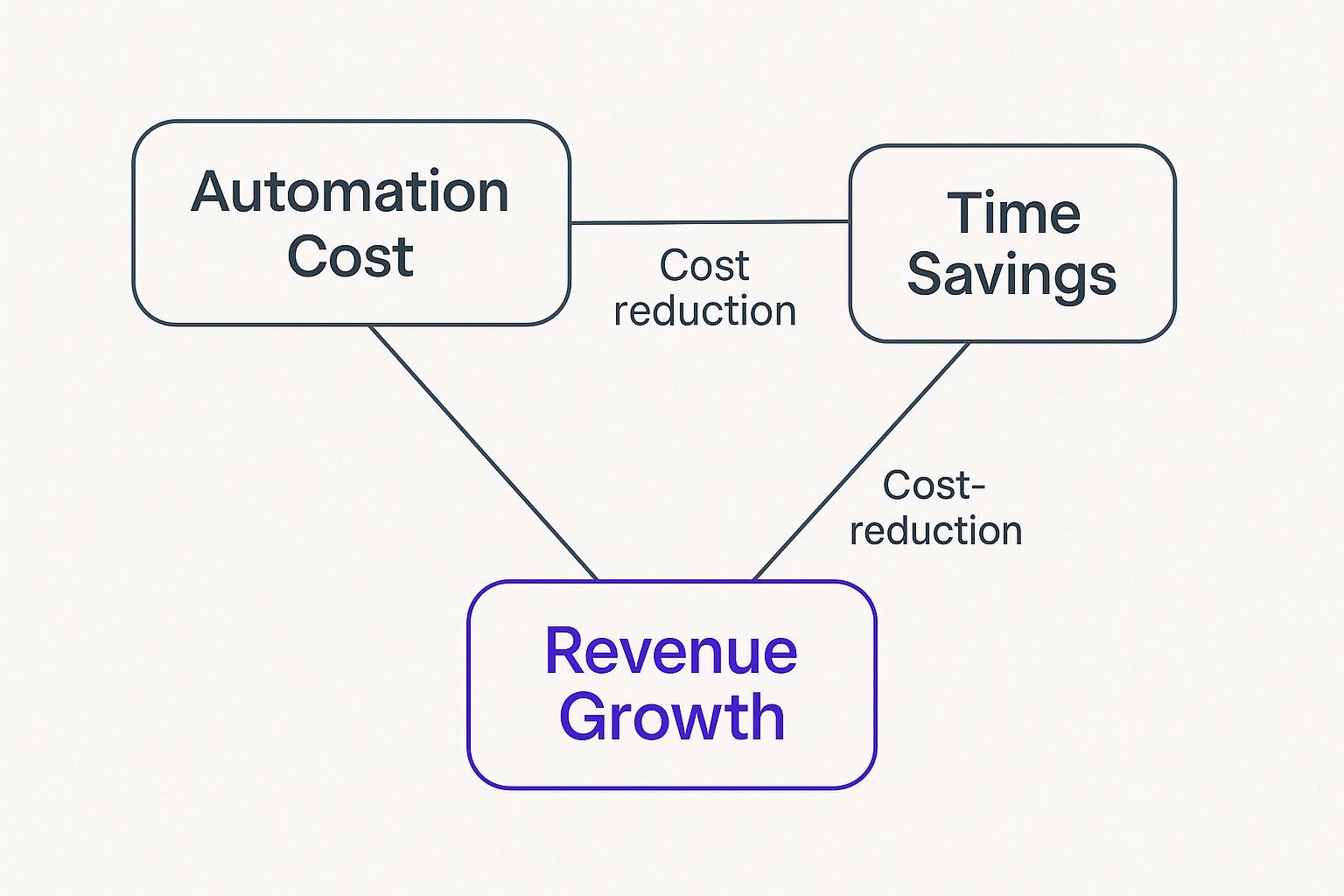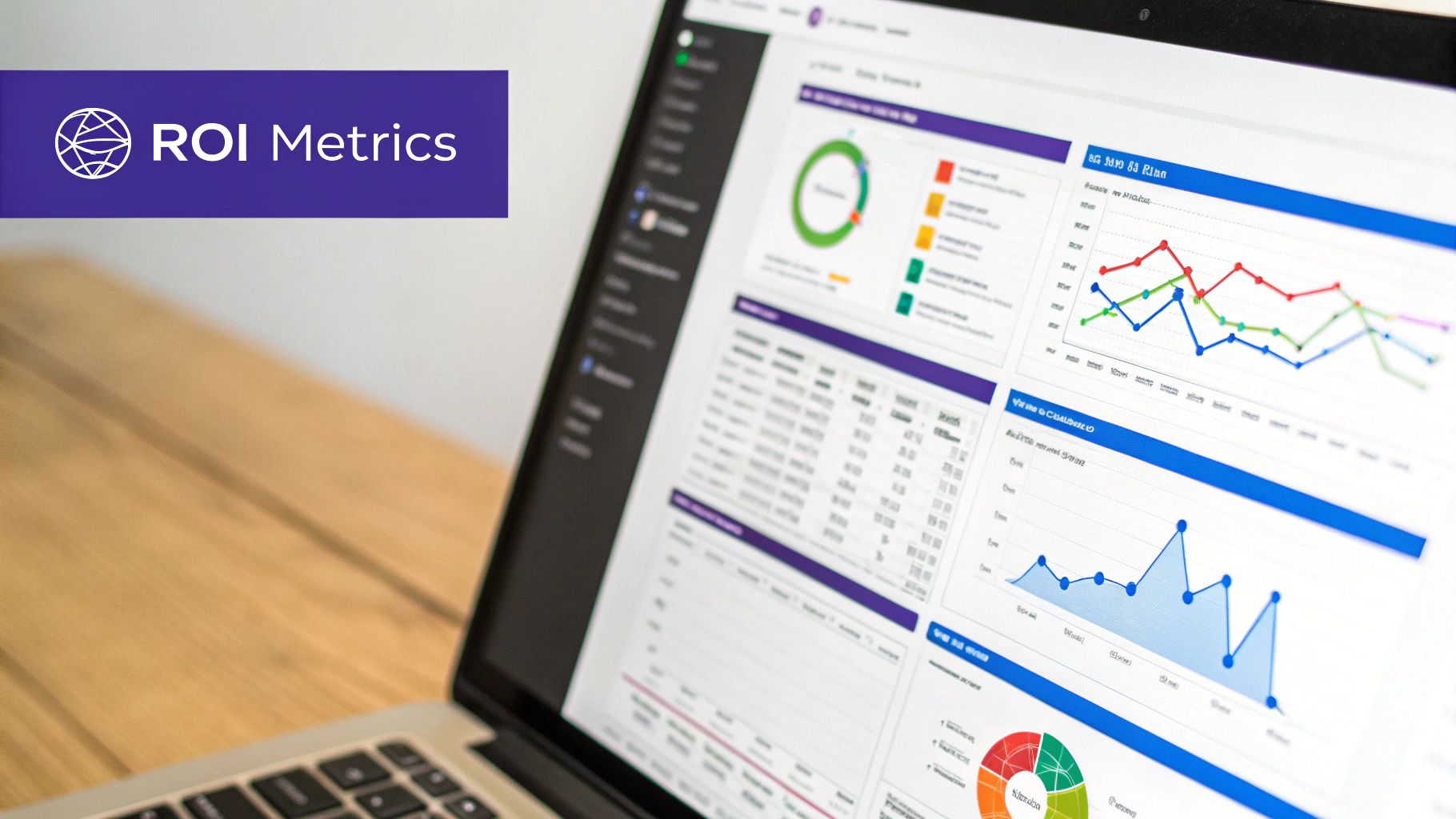Marketing Automation ROI: Your Complete Success Guide
Master marketing automation ROI with proven strategies from industry experts. Learn calculation methods, optimization tactics, and tools that drive results.
Posted by
Understanding Marketing Automation ROI Beyond Basic Metrics

It’s easy to think of marketing automation ROI like a simple receipt: you compare the software cost to the direct revenue it brings in. But this view is too narrow and misses the bigger picture. A better way to think about marketing automation ROI is like tending a vineyard. The initial work and ongoing care produce rewards that grow over time, yielding much more value than just the first harvest. While immediate financial wins are great, they are only a small piece of the total return.
Focusing only on direct revenue can be misleading. The most powerful benefits are often the strategic, long-term advantages that build a stronger, more efficient business. These "hidden" returns are what separate companies seeing average results from those achieving incredible growth. Understanding the full spectrum of value is the key to making smarter decisions and justifying your investment beyond a simple cost-benefit check.
Distinguishing Tactical Wins from Strategic Gains
It's vital to tell the difference between short-term wins and long-term strategic value. Tactical victories are the quick, measurable results you see right after getting started. Strategic gains, on the other hand, are the deep-rooted improvements that create sustainable growth and a real competitive edge.
-
Tactical Wins (The Low-Hanging Fruit): These are the early successes that show your platform is up and running. Think of things like better email open rates from A/B testing subject lines, more leads captured with automated forms, or hours saved by scheduling social media posts. These are encouraging, but they're just the beginning.
-
Strategic Gains (The Compounding Value): This is where automation truly shines. Strategic gains include better lead quality from well-designed nurturing workflows, higher customer lifetime value (CLV) through personalized retention campaigns, and stronger brand consistency across all your channels. These benefits are less about immediate spikes and more about building a resilient marketing engine for the future. For a solid introduction to how AI-driven efforts affect financial outcomes, you can dig into the concept of Return on AI Investment (ROAI).
The Proof Is in the Performance
The data clearly backs up this broader view of ROI. A remarkable 76% of companies using marketing automation report a positive return within the first year. This isn't just a happy accident; it's because these platforms drive real results across the entire business. For example, 80% of users report an increase in leads, and 77% see a significant jump in conversion rates, proving that automation is effective at moving people through the sales funnel. Measuring returns in other specialized areas, like social media, also requires a dedicated approach, as detailed in our guide on how to measure social media ROI.
The Hidden Value Most Businesses Never Measure

While bigger deals and rising sales figures grab all the attention, they don't paint the whole picture of marketing automation ROI. The most powerful returns are often hiding in plain sight, found in the operational efficiencies that quietly build up over time. Think of it like a savings account where small, steady deposits grow into a significant sum. These benefits are less about the immediate revenue spike and more about building a stronger, more resilient business from the inside out.
The smartest companies look past the surface-level dashboards to put a number on these "soft" benefits, turning them into hard, measurable value. Consider the hours saved. Research shows that using automation for social media alone can save a team up to six hours per week. This isn't just about getting time back; it's about reassigning your team's creative and strategic brainpower to activities that truly drive growth—the kind of work that a simple sales report can't capture.
Quantifying Operational Efficiencies
Measuring this hidden value means you need to start asking different questions. Instead of only asking, "How much revenue did this campaign make?" start asking, "How much more efficient did this make our team?" When you assign a dollar value to these improvements, you get a much clearer view of your total return.
Here are the key areas to start measuring:
- Time Savings and Productivity: Your team is your biggest investment. Calculate the hours they no longer spend on repetitive tasks like sending follow-up emails, posting on social media, or segmenting contact lists. Multiply those saved hours by your team's average hourly cost, and you've found a direct financial saving. This is a fundamental piece of proving strong marketing automation ROI.
- Reduced Manual Errors: Every time someone manually enters data or copies and pastes information, there's a risk of error. Automation ensures consistency and drastically cuts down on costly mistakes that can harm customer relationships or burn through your ad budget. While it can be tricky to track, you can estimate its value by looking at the cost of past mistakes.
- Improved Data Quality and Consistency: Automated systems are fantastic at keeping your data clean and organized. Better data leads to smarter segmentation, more effective personalization, and far more accurate reports. This creates a positive ripple effect, making every other marketing activity more successful.
The Strategic Impact of a Better Customer Experience
Ultimately, all these internal efficiencies lead to one major external benefit: a superior customer experience. When your marketing is timely, relevant, and consistent, customers feel it. For example, nurtured leads from automated campaigns make purchases that are 47% larger than non-nurtured leads.
This isn't just a sales number; it's proof that a well-designed customer journey builds trust and delivers real value. By tracking metrics like customer satisfaction (CSAT) scores and engagement rates alongside your automation efforts, you can draw a straight line from operational improvements to a healthier, more loyal, and more profitable customer base.
ROI Calculation Methods That Reflect Real Business Impact
Figuring out your marketing automation ROI shouldn't feel like a guessing game. While a simple formula can give you a starting point, it often misses the full story. To truly understand the value of your automation, you need to look beyond basic math and adopt methods that capture its real impact on your business.
The key is to see how automation costs, time savings, and revenue growth all connect and influence each other.

This visual makes it clear: true ROI isn’t just about the new money coming in. It’s a balance between your investment, direct financial gains, and crucial improvements in how your team operates.
The Standard ROI Formula (And Its Limits)
The most common way to measure marketing automation ROI is a direct financial calculation. It’s a quick and easy way to get a snapshot of performance, but it has some serious blind spots.
The basic formula is: (Financial Gain from Automation - Investment Cost) / Investment Cost
- Financial Gain: This is the new revenue you can directly link to your automated campaigns, like sales from an email nurture sequence or deals closed from leads your platform qualified.
- Investment Cost: This includes everything you spend, from software subscription fees and one-time setup costs to the staff hours needed to manage it all.
The problem with this formula is its tight focus on what can be directly attributed. It struggles to account for complex customer journeys where automation played a supporting, but vital, role. It also ignores "soft" benefits like a more productive and less-stressed marketing team. To get a fuller picture, you can explore our complete guide on the ROI of marketing automation.
A More Complete Approach: Factoring in Savings
To get a number that reflects reality, you must include cost savings in your calculation. Think of it this way: money saved is just as valuable as money earned. This adds a critical layer to the formula.
Here’s the adjusted approach:
- Calculate Total Value Generated: Add your Financial Gain (new revenue) to your Total Cost Savings (think hours saved multiplied by the employee's hourly rate, or reduced spending on other tools).
- Subtract Investment Cost: From that Total Value, subtract your total platform and labor costs.
- Calculate ROI: Divide the final number by your Investment Cost.
This method gives you a much more accurate view of your true marketing automation ROI. For example, research shows automation can lower marketing overhead by 12.2%—a huge saving that the basic formula would completely miss. This expanded view helps justify your investment and highlights its full operational and financial impact.
To help you choose the best calculation for your business needs, here's a comparison of different approaches.
Table: Marketing Automation ROI Calculation Methods Comparison
A detailed comparison of different ROI calculation approaches, showing when to use each method and their respective advantages
| Calculation Method | Best Use Case | Complexity Level | Time Frame | Key Benefits |
|---|---|---|---|---|
| Standard ROI Formula | Quick, high-level financial check-ins or initial budget proposals. | Low | Short-term (Quarterly) | Simple to calculate; provides a fast snapshot of direct revenue impact. |
| ROI with Cost Savings | Businesses focused on operational efficiency and justifying platform costs internally. | Medium | Mid-term (Bi-Annually) | Gives a more complete financial picture by including "soft" savings like time and overhead. |
| Attribution Modeling ROI | Companies with complex, multi-touch sales funnels (e.g., B2B SaaS). | High | Long-term (Annually) | More accurately assigns value to automation's role across the entire customer journey. |
| Customer Lifetime Value (CLV) ROI | Subscription-based or e-commerce businesses focused on long-term growth. | High | Long-term (Annually) | Measures automation's impact on customer retention and repeat purchases over time. |
This table shows there isn't one "perfect" formula. The best method depends on your business goals and what you want to measure. For a quick financial health check, the standard formula is fine. But to understand the deep, long-term value, you'll want to incorporate cost savings and even look at attribution or CLV.
Optimization Strategies That Double Your Returns

Calculating your marketing automation ROI is just the start; the real magic happens when you actively work to improve it. The difference between average and outstanding returns often boils down to small, consistent optimization efforts that build on each other. Think of it like a race car driver who constantly tunes their engine for a few extra milliseconds per lap—over the course of a race, those tiny adjustments create a massive lead.
Many companies see impressive 200-300% ROI improvements not from a single, giant overhaul, but through a series of smart, data-driven refinements. This means moving beyond a "set it and forget it" mindset and embracing a culture of continuous improvement. The goal is to find what truly resonates with your audience and double down on it.
Pinpointing and Removing Workflow Bottlenecks
The first step is to figure out where your automation is falling short. A workflow bottleneck is any point in your process where leads get stuck, engagement plummets, or conversions just don't happen. By digging into your campaign data, you can find these friction points and fix them.
- Audit Your Drip Campaigns: Are you seeing a major drop-off in opens or clicks after a specific email in your sequence? This is a classic bottleneck. It could mean the content is no longer relevant, or the call-to-action isn't clear enough.
- Refine Your Lead Scoring: If your sales team is complaining about low-quality leads, your scoring model is likely the culprit. Adjust the point values based on which actions truly signal buying intent.
- Optimize Timing and Frequency: Sending too many messages can lead to unsubscribes, while sending too few means you're missing opportunities. Test different sending schedules to find the sweet spot for maximum engagement. For a deeper look, check out our guide on building effective marketing automation workflows.
Advanced Tactics for Amplifying Returns
Once you’ve cleared the basic bottlenecks, you can introduce more advanced strategies to push your ROI even higher. These methods focus on delivering a deeply personalized experience at scale. To truly boost your returns, consider implementing proven email marketing automation best practices that improve engagement and deliverability.
Techniques like dynamic content, which changes based on a user’s data or behavior, can make every message feel personal. Furthermore, predictive analytics can help you anticipate customer needs before they even arise, allowing for proactive and highly effective marketing actions that supercharge your returns.
What Exceptional Marketing Automation ROI Actually Looks Like
It’s one thing to calculate your return on investment, but it’s another thing to know if that number is actually good. So, what does a stellar marketing automation ROI look like in the real world? The truth is, there's no single magic number. Your results will depend on your industry, business model, and how long you’ve been using automation.
While some companies barely break even, others see massive returns because they've successfully matched their strategy with their technology. The goal is to set realistic benchmarks and build from there. Think of it like climbing a ladder—a business just starting with simple email workflows can't expect the same results as a company with a fine-tuned, multi-channel system.
Financially, studies show a powerful trend: for every dollar spent, companies see an average return of $5.44 from marketing automation. This figure shows just how efficient this approach can be. To get a better sense of the numbers, you can explore more marketing automation statistics.
Benchmarks by Industry and Maturity
Exceptional ROI isn't a one-size-fits-all metric. Performance goals change a lot from one industry to another, reflecting different customer journeys and sales cycles. Understanding these nuances helps you set achievable targets and spot opportunities for improvement.
- B2B and SaaS: In these fields, a great ROI is directly connected to lead quality and shortening the sales cycle. The best performers aren't just getting more leads; they are delivering sales-ready opportunities that convert faster. A key sign of success is when nurtured leads make purchases that are 47% larger.
- E-commerce and B2C: Here, success is all about boosting customer lifetime value (CLV) and repeat purchases. Outstanding ROI is driven by personalized product suggestions, abandoned cart reminders, and loyalty programs that give customers a reason to keep coming back.
The Strategic Factors Driving Top Performance
Why do some companies achieve incredible returns while others get stuck? It almost always comes down to strategy. The businesses with the best marketing automation ROI typically share these traits:
- Deep Customer Understanding: They use data to create rich customer profiles, which allows for incredibly relevant and personalized communication.
- Sales and Marketing Alignment: Their automation platform isn't just a marketing tool; it’s a bridge that ensures a smooth handoff of qualified leads to the sales team.
- A Culture of Testing: They are always experimenting. From email subject lines to the logic of an entire workflow, they continuously test and refine to discover what truly resonates with their audience.
ROI Killers That Silently Destroy Your Returns
Even a perfectly planned automation strategy can fall short if quiet ROI killers are at work. Think of them like a slow, undetected leak in a swimming pool—these problems drain your resources and results over time, often going unnoticed until the damage is significant. Understanding these threats is the first step toward protecting your marketing automation ROI and ensuring your efforts deliver sustainable growth.
These issues are more common than you might think and can turn a promising investment into a frustrating expense. By learning to spot the early warning signs, you can act quickly to fix the leaks before your returns suffer.
The Dangers of Dirty Data
The most common and destructive ROI killer is poor data hygiene. Your automation platform is only as smart as the data you feed it. If your contact lists are full of outdated emails, duplicate entries, or incorrect information, your campaigns are destined to fail.
Imagine trying to deliver packages to addresses that don't exist. You'd waste time, fuel, and money. It's the same with automation. Every bounced email and misdirected message hurts your deliverability scores and wastes resources. This directly leads to lower engagement, weaker lead scoring, and a skewed view of your campaign performance, making it nearly impossible to calculate an accurate marketing automation ROI.
When Good Intentions Go Wrong
While data is a major culprit, other issues can quietly sabotage your success. It’s crucial to recognize them early.
- Over-Automation and Impersonalization: There's a fine line between efficiency and annoyance. Bombarding your audience with a constant stream of generic, robotic messages is a surefire way to drive them away. When automation lacks a human touch, engagement plummets, and so does your ROI. Businesses report that using automation for personalization is a key to success, but when done poorly, it backfires spectacularly.
- Misaligned Sales and Marketing Processes: Automation can generate thousands of leads, but if the sales team isn't equipped or prepared to handle them, those opportunities vanish. A lack of communication between marketing and sales creates a major bottleneck where qualified leads grow cold, destroying any potential return.
- Inadequate Measurement: Simply tracking opens and clicks isn't enough. Without a solid framework to measure what truly matters—like lead quality, conversion rates, and customer lifetime value—you’re flying blind. You can't fix what you don't measure, and you certainly can't prove your ROI without the right data to back it up.
Tools and Technologies That Transform ROI Measurement
Trying to calculate your marketing automation ROI by hand is like navigating a cross-country road trip with only a paper map. Sure, you might get there eventually, but it’s going to be slow, inefficient, and full of wrong turns. The right technologies are your GPS, turning ROI tracking from a frustrating chore into an automated engine that delivers real-time, useful insights. These tools make measurement more accurate, comprehensive, and ultimately, more valuable for making smart decisions.
It’s time to move past basic spreadsheets and into dedicated analytics and attribution platforms. The objective is to build an integrated system where data flows smoothly, painting a complete picture of how your automation efforts impact the bottom line. This gets rid of manual data entry and lets you focus on strategy instead of building reports.
Core Components of a Modern Measurement Stack
Building a solid measurement system doesn't mean you need a dozen different subscriptions. It's about picking the right tools that play well together. A strong setup usually includes a few key components that tackle different parts of the ROI equation.
- Analytics Platforms: Tools like Google Analytics are the foundation. They track website traffic, user behavior, and goal completions, giving you a baseline for performance. Connecting your automation platform to your analytics is the first step in linking campaigns to what people do on your site.
- CRM Integration: Your Customer Relationship Management (CRM) system holds the most valuable data: customer interactions, deal stages, and final revenue. When you integrate your CRM with your marketing automation platform, you can directly connect marketing activities to closed sales—the key to proving financial return.
- Data Visualization Tools: Raw numbers are hard to make sense of. Visualization tools like Tableau or Looker Studio transform complex data into clear, easy-to-digest dashboards. These dashboards make it simple to show your marketing automation ROI to stakeholders who aren't marketing experts.
To better understand how these tools fit together, here’s a comparison of different categories of platforms that help measure marketing automation ROI.
Marketing Automation ROI Measurement Tools
Comprehensive comparison of tools and platforms for measuring marketing automation ROI, including features, pricing, and integration capabilities
| Tool Category | Key Features | Pricing Range | Integration Level | Best For |
|---|---|---|---|---|
| All-in-One Automation Platforms | Email marketing, lead nurturing, CRM, and built-in analytics. | $$ - $$$$ | High (often includes native CRM and analytics) | Businesses wanting a single, unified system for execution and measurement (e.g., HubSpot, Marketo). |
| Dedicated Analytics Platforms | Web traffic analysis, conversion tracking, user behavior funnels. | Free - $$ | Medium (Integrates with most marketing tools) | Any business with a website needing to track on-site behavior and campaign sources (e.g., Google Analytics). |
| CRM Systems | Lead and contact management, sales pipeline tracking, revenue reporting. | $ - $$$ | High (The central hub for all customer and sales data) | Sales-driven organizations focused on connecting marketing efforts directly to closed deals (e.g., Salesforce). |
| Data Visualization Tools | Customizable dashboards, interactive reports, data blending from multiple sources. | Free - $$$ | High (Pulls data from almost any source) | Teams that need to communicate ROI and performance metrics clearly to leadership (e.g., Tableau, Looker Studio). |
| Multi-Touch Attribution Software | Advanced attribution models (linear, U-shaped, time-decay), cross-channel journey mapping. | $$$ - $$$$ | Very High (Requires deep integration with all marketing channels) | Companies with complex, multi-channel customer journeys who need to assign value beyond the last touchpoint. |
This table shows that no single tool category does everything perfectly on its own. The real power comes from combining them to create a full view of your performance, from the first ad click to the final sale.
Advanced and Emerging Technologies
For businesses with complex customer journeys, more specialized tools are necessary. Multi-touch attribution platforms, for example, help assign credit more accurately across various touchpoints—from the first ad a prospect saw to the final email they clicked.
Looking ahead, AI-powered analytics are becoming more common, offering predictive ROI modeling that can forecast a campaign's potential success before you even launch it. To effectively measure and boost ROI, using the right technology is essential, and knowing about various content automation tools can give you a significant advantage.
Ultimately, the right technology stack brings all your data together, providing a single source of truth for your marketing automation ROI.
Ready to see exactly how much time and money you can save? The EndorseFlow ROI Calculator is designed to give you a clear, data-backed estimate of your potential returns. Stop guessing and start seeing the real value of automated testimonial and social media management.